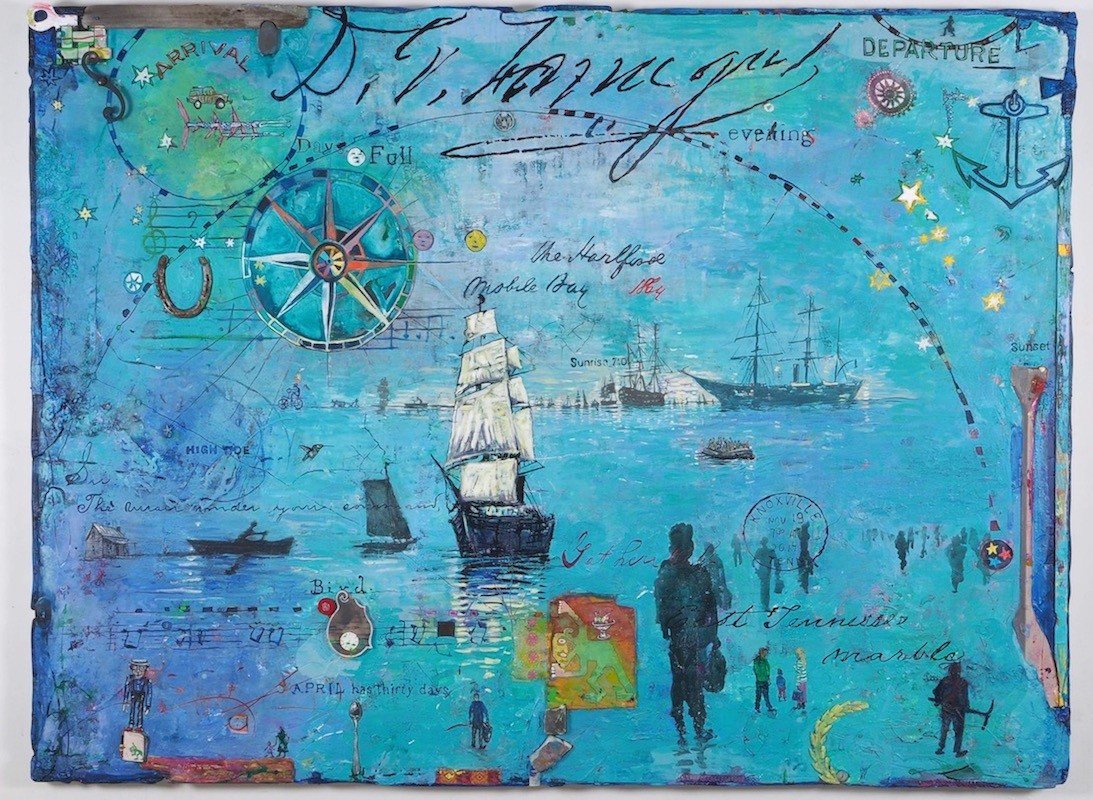This week, artist Andy Saftel installed his major new, large-scale work, a painting honoring Admiral David Farragut, commissioned by the soon-to-open Hyatt Place Knoxville Downtown, the new hotel in the historic Farragut building, 530 S. Gay St.
Saftel grew up hating school. By the time high school graduation rolled around, he never wanted to see the inside of another classroom. Then his grandmother wrote him a letter offering to pay for college if he would go.
His first thought was to say, “No, thanks.” Reconsidering, thinking he might like going to art school, he asked if that would be OK. So, he enrolled at the San Francisco Art Institute.
“The first class I went to the teacher said, ‘I want you to take the energy from your body and put it into warm colors.’ That didn’t make any sense to me,” he said during a visit to his home studio in the Sequatchie Valley, south of Crossville, where Saftel and his wife, Susan Knowles, a curator and writer, live on acreage that opens up into the valley.
Saftel earned a BFA, at the Art Institute. But it wasn’t his classes or painting there that set him on the course he has followed. After graduation, he moved around a bit, eventually finding himself in Bozeman, Montana.
“I worked at a sign company, using routers to carve letters into redwood signs. There was something about it appealed to me. I could have gone on making signs.”
He started thinking about combining painting with letters and other marks carved into wood. To accomplish those techniques, Saftel began working on plywood panels instead of canvas for his working surface.
The application of words has stayed a constant in Saftel’s work. To take some of the hard edges and boxiness away from plywood, he used routers, saws and ordinary hammers to break the outside lines of the plywood mounted on wood backing framework.

Letter from Admiral Farragut, a flag officer in the U.S. Navy during the Civil War, written on July 16, 1862, to the captain of the Hartford, the ship that’s sitting just below Vicksburg, noting that the ship’s cannons had not been fired and pointing out the regulation that required him to do so. Farragut’s signature was projected onto the plywood picture surface, at the scale Saftel wanted, during early stages of work on the piece, traced in pencil, then cut in with a router, the groove later filled with paint.
There are also other constants in Saftel’s paintings. There will always be a direct or oblique reference to time: sunrises, sunsets, morning light and weather. There’s usually some form of a clock. The Farragut has an actual watch mounted into a carved-out recess in the upper left of the painting. The movement of time is also represented by an oar embedded into the surface and a painted anchor. Often, found objects are attached to the surface or mounted in partially cut-out areas.
The router-cut words usually come from something that Saftel came across researching the subject of his painting, such as Admiral Farragut’s signature, which he found in a historic letter, written to ask why there were no reports of the cannons on the ship he commanded during the Civil War.
Saftel has held onto the letter his grandmother wrote him. He often uses words, in her handwriting, in the composition of pieces.

Circled words, in Saftel’s grandmother’s hand-written letter addressed to him, that he has used multiple times in various paintings. He projects the words onto the picture surface, sometimes tracing them in pencil and routing them into the surface, sometimes copying them directly in paint.
Saftel’s paintings aren’t really images, in the sense of most paintings being pictures. They are more visual narratives that tell a story of some kind. They are also a kind of map that one can follow along a path to understand what the painting is about. As such, Saftel is an emotional cartographer more than a painter, although most of his work has a sense of internal lighting that comes from the combination and layering of colors he uses.
In addition to the new work at the downtown Hyatt Place, major pieces can be found at Children’s Hospital, Knoxville Museum of Art, Arrowmont School in Gatlinburg and other places around the area, in addition to private collections.

